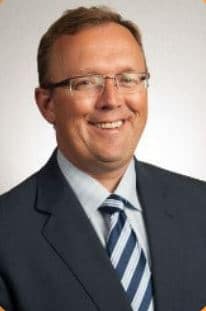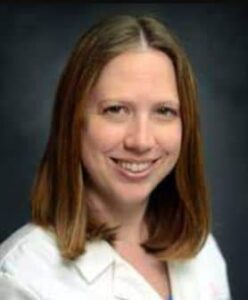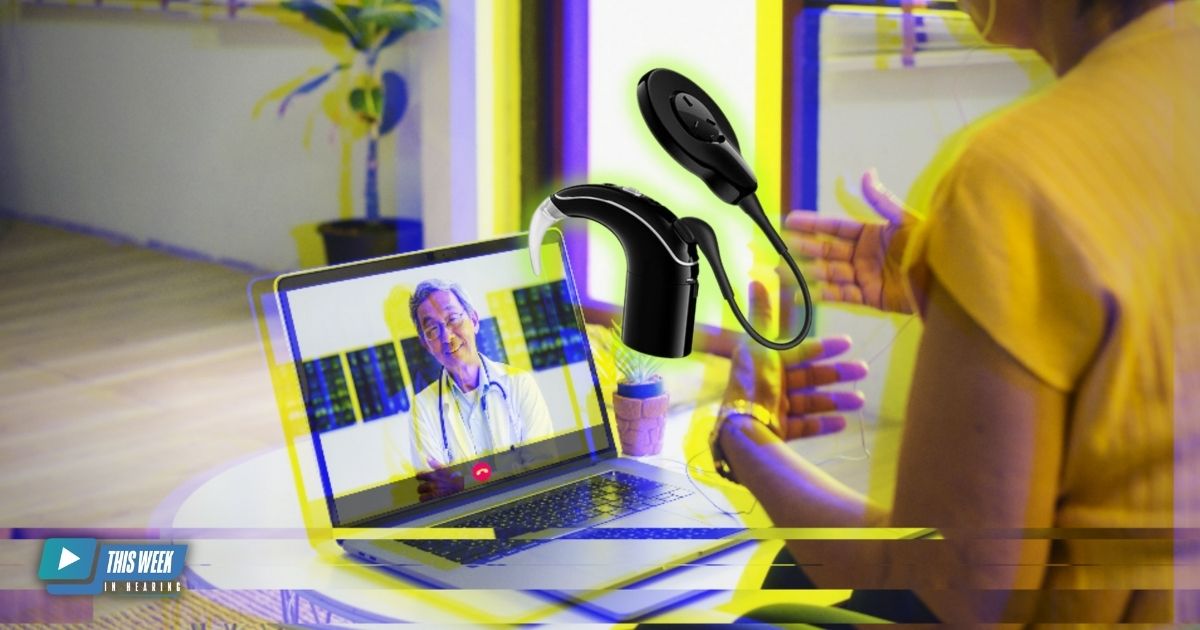It is widely believed that only 5% of the more than 2 million adults who are potential candidates for cochlear implant (CI) technology have been treated. There are several reasons for this low uptake rate, including the limited number of audiologists and clinics who work with cochlear implants. In addition, these limited resources create an aftercare burden, as many CI recipients must travel long distances for a high number of in-person appointments.
Our guest, Dr. Sandra Porps, discusses a recent study that demonstrates remote aftercare is not only popular among adult CI recipients, but improves outcomes.
Study referenced in this interview:
Full Episode Transcript
Hello,
and welcome to another episode
of this Week in Hearing.
I’m Brian Taylor.
Our topic this week is the use
of remote aftercare services for
cochlear implant patients.
Here to discuss this important
topic in a new study that looks
at remote care with these
patients is clinical
audiologist dr.
Sandra Porps of the Michigan
Ear Institute.
Welcome to this week in Hearing.
Sandra,
it’s great to have you with us.
Thank you so much for having me,
Brian.
I’m really looking forward
to our talk today. Yeah,
I guess before we get started,
let’s kick things off by having
you tell our audience a little
bit about yourself and your role
at the Michigan Ear Institute.
Great. Well, I live in Michigan.
I’m from Wisconsin originally.
So Midwest.
I did my undergrad work at
Marquette University
in Milwaukee,
and then I did my graduate
work at Central Michigan.
I did my fourth year at Michigan
Ear Institute,
and I have stayed on ever since
for about almost 18 years now.
So I am a clinical audiologist,
and then now I work primarily
with cochlear implant patients.
Great.
And that’s why we had you on the
show today to talk about
cochlear implant patients and
your expertise in that area.
My first question for you,
Sandra,
is I read recently that there
are only about 5% of the more
than about 2 million adults who
are potential candidates for
cochlear implant technology have
actually been treated.
That number seems really low 5%
at potentially 2 million.
Can you tell us a little bit
why that population is
so undertreated?
Yes,
it makes me sad, too.
There’s a lot of factors.
So accessibility is a huge one.
If you look at our study we
dropped and which we’ll get
into, which we’ll talk about,
but the number of visits
required in that first year,
that could be time off work,
that could be travel time,
that could be a loved
one’s time off work.
So accessibility in terms of
time is certainly a
big part of it.
Accessibility in terms
of centers.
There are some areas like
Michigan where I am,
where we have a lot of really
great cochlear implant centers.
But then there are some of my
colleagues out in the west where
my colleague might live in
Colorado but might have to drive
to Wyoming to get treatment
for some of these people.
So that’s certainly part of it
as well. And then the referrals,
a lot of physicians might not
know what the current criteria
is that their patients really
can get cochlear implants
a lot earlier.
Now with the expanded Medicare
access last fall than they
were previously.
So Medicare previously the
criteria was you had to score
40% or less on sentence testing.
Now it’s 60% or less.
So that criteria has
been expanded,
which opens cochlear
implantation up to
even more people.
But we just have to get the word
out to physicians and other
referral center that your
patients can be helped a lot
sooner than you think they can.
Yeah, and I know.
Audiologists are still
unfamiliar with the new criteria
candidacy requirements.
So it’s good to get the word
out. And actually,
we’ve had other guests on This
Week in Hearing recently that
have talked in detail about the
60 by 60 requirements that are
new, which is wonderful. Yeah,
I agree.
Getting the word out there
is so important,
and I thank you for the work
that you do to do that.
Well,
before we talk about your study,
I think it would be helpful if
you could kind of give us a
little context around the
traditional sequence of
appointments for adults who are
cochlear implant wearers. Yes.
So traditionally there’s a
number of appointments in that
first year at our own center,
Michigan Ear,
prior to this study,
you had your activation
appointment,
then you had follow ups at one
week, two week, and three weeks.
Then you had a follow up a month
later, then three months later,
then six months later,
and eventually once a year.
So that was a whole lot
in that first year.
And that was a big commitment
for our patients to commit to,
I would imagine.
Especially if you’re driving any
more than even and a half an
hour. That’s a big burden.
Well,
and you don’t think about
Michigan being a very large
state, but it is.
At Michigan Ear Institute,
over 50% of our patients have
a three hour plus drive.
Yeah.
So that’s a big time commitment
for all that follow up care.
Well,
let’s talk about your study.
I know that you’re the lead
author on a recently published
multicenter study that looks
at a better way to care for
patients after implantation.
So tell us a little bit about
the study and what you found.
Sure.
So I got to be author of this
paper with some wonderful
colleagues.
There were five audiologists
that participated across three
centers, us in Michigan,
and then two in Texas.
And what we did is taking that
very extensive model of so
many follow up visits.
In the first year,
we shortened that down
to four visits.
So you have activation one
month, three month,
and then six month,
and then annual as needed.
So that took that from a number
of visits down to four,
which is a lot easier for
our patients. Great.
And so what did you find
in your study? Like,
did the patients benefit from
the remote options?
Were the outcomes different?
Tell us more about what you
found. So in the findings,
there’s a number of things
that we found.
The first was we look
at audiologically.
How are these patients hearing
compared to their traditional
counterparts?
Because if they were delayed
in their hearing abilities,
if they weren’t reaching
those same milestones,
then this would not
be effective.
And we found that at three
months and six months,
they were meeting their
hearing milestones.
They were scoring very,
very similarly to patients that
underwent the traditional model.
So that was great.
The second part was how happy
are they overall with their
hearing? And they’re very happy.
Again scored very similarly to
the patients that went through
traditional model and the last
is their service were they happy
with the service they received?
And 14 out of 14 subjects that
underwent the full that stayed
with us throughout
the full trial.
They all rated their services
excellent, which was fantastic.
We were very happy to see that.
Yeah,
those are fantastic outcomes.
And for those that want
to read the study,
there’ll be a link in the show
notes to where that study
was published.
I think it was just published
a few months ago,
if I’m not mistaken. Right?
Yes,
in Cochlear Implants
International,
which was very nice. Well,
as we wrap things up here,
could you maybe share with us,
given your 18 years of
experience with this population,
what are some things that other
hearing care professionals
really need to know about remote
CI aftercare cochlear
implant candidacy?
What insights might you want
to share with our audience?
One of the parts of this study
was embracing the remote
care through Cochlear.
You can have remote visits
either via remote assist
with your audiologist.
You can have remote checks
via your Cochlear app,
and you can also have visits
with the recipient
support manager.
And I know at first when
we started this,
we weren’t really sure that this
population was going
to embrace that,
and I found quite the
opposite was true.
They absolutely embraced
the remote options.
And in many ways,
I feel much closer
to my patients,
being that I could see
into their world.
And doing a remote assist
appointment, for example,
I can see their living room.
I can see where are you sitting,
where’s your spouse sitting when
you’re trying to watch TV.
And being able to do this
together really helped give
realistic expectations and help
the counseling aspect.
When I start talking with my
patients about using
remote options,
the first question
I always say is,
have you ever done a FaceTime
video with your grandkids or
your kids? And when they say,
oh, yes,
we do that all the time.
If you can do a FaceTime video,
you can do a remote session,
whether that is with your
audiologist or with the
recipient support manager,
you can do any of the
remote tools.
If you can do a FaceTime video,
well,
that’s really interesting and
great to know that if you
make it available,
let people know that that remote
care is an option,
that they tend to embrace it.
I think that’s a lesson for all
hearing care professionals
out there. Yes,
it’s been a great journey.
Well,
thank you so much for spending
time with us.
This is great information.
And like I said,
there’ll be a link in the show
notes to the study that you
were the lead author on.
And again,
our guest today clinical
audiologist, dr.
Sandra Porps of the Michigan
Ear Institute.
Thank you so much for your
time and your expertise.
Thank you so much for having me.
Be sure to subscribe to the TWIH YouTube channel for the latest episodes each week, and follow This Week in Hearing on LinkedIn and Twitter.
Prefer to listen on the go? Tune into the TWIH Podcast on your favorite podcast streaming service, including Apple, Spotify, Google and more.
About the Panel
 Brian Taylor, AuD, is the senior director of audiology for Signia. He is also the editor of Audiology Practices, a quarterly journal of the Academy of Doctors of Audiology, editor-at-large for Hearing Health and Technology Matters and adjunct instructor at the University of Wisconsin.
Brian Taylor, AuD, is the senior director of audiology for Signia. He is also the editor of Audiology Practices, a quarterly journal of the Academy of Doctors of Audiology, editor-at-large for Hearing Health and Technology Matters and adjunct instructor at the University of Wisconsin.
 Sandra L Porps, Au.D. CCC-A is a clinical audiologist at the Michigan Ear Institute. Dr. Porps received her Doctorate of Audiology from Central Michigan University in 2005. She is a member of the cochlear implant team and specializes in cochlear implantation for single sided deafness, asymmetric hearing loss, and cochlear implantation after acoustic neuroma removal. Dr. Porps also has an interest in clinical efficiency and the use of telehealth to improve patient experience and outcomes. She is committed to education and mentorship and enjoys partnerships with several regional audiology programs. Dr. Porps has published book chapters and peer reviewed journal articles ranging from topics in basic audiology to cochlear implant outcomes and clinical efficiency.
Sandra L Porps, Au.D. CCC-A is a clinical audiologist at the Michigan Ear Institute. Dr. Porps received her Doctorate of Audiology from Central Michigan University in 2005. She is a member of the cochlear implant team and specializes in cochlear implantation for single sided deafness, asymmetric hearing loss, and cochlear implantation after acoustic neuroma removal. Dr. Porps also has an interest in clinical efficiency and the use of telehealth to improve patient experience and outcomes. She is committed to education and mentorship and enjoys partnerships with several regional audiology programs. Dr. Porps has published book chapters and peer reviewed journal articles ranging from topics in basic audiology to cochlear implant outcomes and clinical efficiency.







